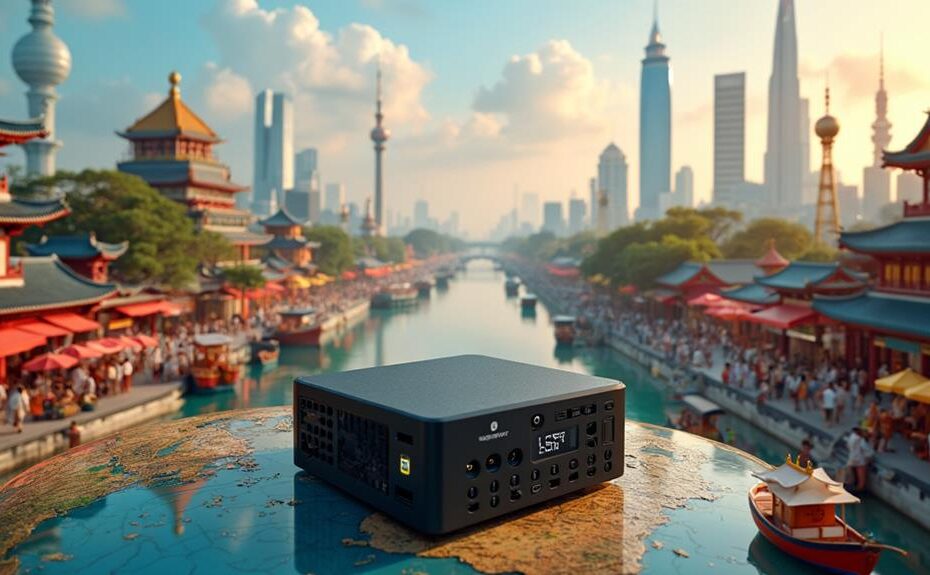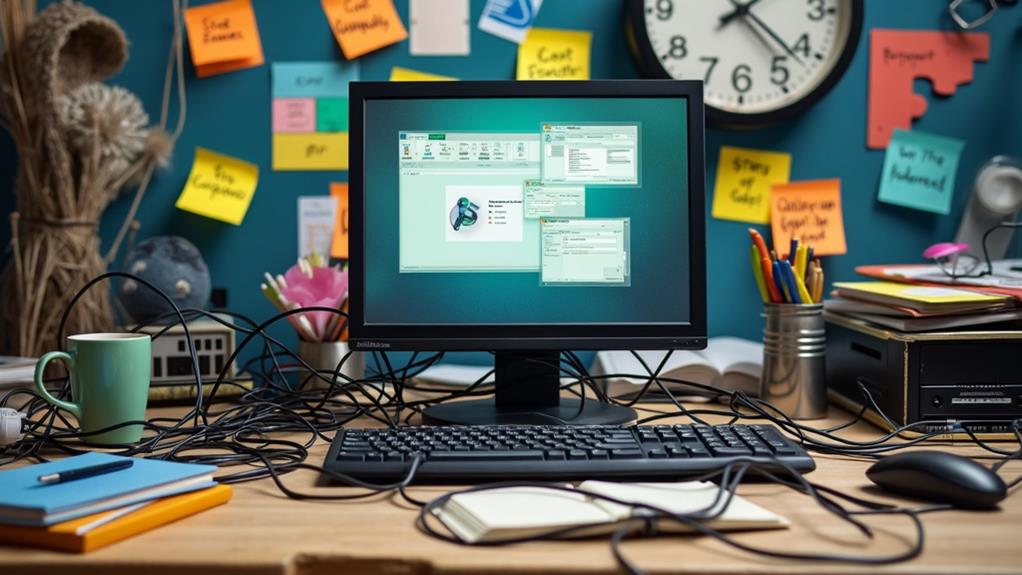



Mini PCs adjust to global market demands by honing in on compact design, advanced functionality, and diverse consumer needs. With the market projected to grow from $22.7 billion in 2023 to $45.22 billion by 2031, you'll see manufacturers focusing on multitasking capabilities and energy efficiency to meet evolving preferences. The Asia-Pacific region leads growth with a 7% CAGR, driven by urbanization and rising middle-class demands. By integrating IoT and smart home features, companies also address trends in interconnected living. Explore further, and you'll uncover more about how these adaptations are shaping the future of Mini PCs.
Key Takeaways
- Mini PC manufacturers adapt by innovating product features to meet diverse consumer preferences, such as multitasking capabilities and energy efficiency.
- Companies leverage regional market insights to tailor their offerings, addressing unique demands in Asia-Pacific, North America, and Europe.
- Strategic partnerships and mergers enhance market penetration, allowing manufacturers to respond effectively to varying local market conditions.
- Investment in R&D drives technological advancements, enabling mini PCs to integrate IoT capabilities and smart home features for broader appeal.
- Continuous monitoring of market trends helps manufacturers adjust pricing strategies and product specifications to remain competitive and meet consumer needs.
Mini PCs Market Overview
The burgeoning demand for Mini PCs reflects a remarkable shift in consumer preferences towards compact and efficient computing solutions. In 2023, the global Mini PC market was valued at USD 22.7 billion, with projections estimating it will reach USD 45.22 billion by 2031. This substantial market growth underscores the increasing demand for portable computing solutions, driven by technological advancements and the need for energy-efficient devices. As seen in the high customer satisfaction regarding Mini PCs, features such as dual monitor support and advanced wireless connectivity enhance their appeal.
Notably, consumer electronics accounted for over 40% of the Mini PC market share in 2023, emphasizing their critical role in both home and office environments. The market is segmented by components, with the processor segment poised for significant expansion, projected to grow at a CAGR of over 6.5% from 2024 to 2032.
The Asia-Pacific region is anticipated to dominate the Mini PC market, with a CAGR of 7% during the same period. This growth is largely attributed to rising demand for compact computing solutions in rapidly developing countries like China and India. As technological advancements continue to enhance processing power, expect the demand for Mini PCs to remain robust, driving overall market dynamics in the coming years.
Drivers of Mini PC Demand
Growing consumer interest in Mini PCs is driven by several key factors that reflect changing work and lifestyle dynamics. The surge in remote work and online learning has considerably boosted demand for compact devices, with Mini PCs emerging as ideal solutions for home offices and educational settings. Their small size doesn't compromise performance; thanks to technological advancements, these devices can rival traditional desktops, appealing to users who prioritize high performance in a limited form factor. Additionally, the advantages of Mini PCs in retail highlight their potential in commercial environments, where efficiency and space-saving are essential.
Moreover, Mini PCs are increasingly adopted in commercial applications across sectors like retail and hospitality, where space-saving and efficient computing solutions are essential. The rise of IoT capabilities and edge computing further fuels demand, as Mini PCs serve as effective data processing nodes in smart home and automation applications.
As consumer preferences shift towards energy-efficient and multifunctional devices, Mini PCs are well-positioned to meet expectations for sustainable and versatile computing solutions. This alignment with market trends not only enhances their appeal but also contributes considerably to overall market growth, making Mini PCs a smart choice for diverse users looking for reliability and efficiency in their computing needs.
Current Market Trends
Mini PCs are carving out a significant niche in the technology market, reflecting a shift towards compact and energy-efficient computing solutions. Market trends indicate a projected growth rate exceeding 5% CAGR from 2024 to 2032, driven by a rising demand for compact devices. Consumers are increasingly seeking multitasking capabilities, and technological advancements are key to meeting these diverse needs. New models, like ASRock's Mini PC Jupiter 600 and Intel's NUC 13 Extreme, showcase enhanced performance, catering to both gaming and professional content creation sectors. Importantly, devices such as the Beelink S12 Pro exemplify how mini PCs can support advanced specifications like 4K dual display capabilities. Additionally, the demand for IoT-enabled mini PCs is on the rise, particularly as smart home automation becomes more mainstream. This adaptability highlights how mini PCs can align with modern consumer preferences. Moreover, the Asia-Pacific region is poised for impressive growth, expected to achieve a 7% CAGR during the same period. This surge is largely fueled by a growing middle class in need of cost-effective and compact computing solutions. As mini PCs continue to evolve, their compact design and energy-efficient computing will remain central to their appeal, ensuring they meet both current and future market demands effectively.
Regional Market Insights
As the demand for compact computing solutions surges, the Asia-Pacific region stands out as a powerhouse in the Mini PC market. Countries like China, India, and Japan are leading this growth, with a projected CAGR of 7% from 2024 to 2032. This robust expansion is driven by the need for cost-effective computing solutions tailored to diverse consumer preferences.
North America, however, generated the largest revenue share in 2022, bolstered by strong technological advancements and a well-established consumer base. This region continues to innovate, setting trends that resonate globally.
Europe's market dynamics are influenced by stringent regulations that promote sustainability initiatives, resulting in Mini PCs designed with eco-friendly practices in mind.
Meanwhile, Latin America and the Middle East & Africa present untapped market potential, with emerging markets offering new growth opportunities for Mini PC manufacturers. By understanding these regional market insights, companies can strategize effectively, enhancing their product offerings to meet local demands.
As competition intensifies, adapting to these diverse market conditions will be essential for success in the global Mini PC landscape.
Competitive Landscape Analysis
Maneuvering the competitive landscape of the Mini PC market reveals a dynamic environment shaped by key players like Acer, Intel, Dell, and Apple, which together commanded over 10% of the market share in 2023. These companies emphasize product innovation and differentiation to satisfy diverse consumer needs, particularly for high-performance devices. For instance, Intel's NUC 13 Extreme and Lenovo's ThinkCentre M70q Gen 3 highlight how industry leaders adapt to increasing demands for compact, powerful solutions in gaming and professional settings.
The Asia-Pacific region is poised to dominate the Mini PC market, projected to grow at a CAGR of 7% from 2024 to 2032. This growth stems from a burgeoning middle class seeking cost-effective computing solutions, coupled with the presence of major manufacturers.
Strategic partnerships and mergers and acquisitions are prevalent competitive strategies, enhancing market penetration and allowing companies to tailor their offerings to regional preferences. Market segmentation reveals that the commercial office sector is expected to capture the largest share, driven by escalating demands from remote work and digital transformation initiatives. Understanding this competitive landscape is essential for stakeholders aiming to thrive in this evolving market.
Technological Innovations in Mini PCs
How have technological innovations transformed the landscape of Mini PCs? The integration of Intel's 13th Gen Core processors has greatly enhanced multitasking capabilities, enabling you to run demanding applications like gaming and content creation with ease. These advancements reflect a broader trend towards energy efficiency, as manufacturers prioritize compact computing solutions that require less power while delivering high performance.
Companies like ASRock and Dell have made substantial R&D investments to drive miniaturization and improve graphics capabilities. For instance, ASRock's Mini PC Jupiter 600 offers multi-display support and multiple USB ports, catering to various consumer needs, including digital signage and remote work applications. Similarly, Dell's OptiPlex Micro PCs are designed to handle intensive multimedia tasks while ensuring robust security features.
Moreover, smart home integration is becoming a crucial aspect of Mini PCs. Devices like Dusun IoT's DSGW-290 smart home hub exemplify how these products can provide seamless connectivity and automation in smart environments. Overall, these technological innovations position Mini PCs as versatile tools that meet diverse global market demands, seamlessly blending functionality with compact design.
Challenges Facing the Industry
Increasingly, Mini PC manufacturers face a myriad of challenges that threaten their market viability. Competition from traditional desktops and laptops creates a crowded landscape, making it difficult for Mini PCs to differentiate themselves. This saturation can directly affect their market position, as consumers may favor established alternatives. Supply chain disruptions, particularly during economic fluctuations, hinder production and availability, impacting responsiveness to shifting market demands.
Moreover, rapid technological changes necessitate continuous innovation to meet evolving consumer preferences. As customers become more discerning, Mini PC manufacturers must balance performance with energy efficiency, endeavoring to deliver high-performance devices without excessive energy consumption. This challenge is compounded by pricing pressures from budget-conscious consumers, which complicate efforts to maintain profitability while offering competitive features.
In this environment, staying ahead of the competition requires a keen understanding of market trends and consumer behavior. Manufacturers must not only adapt to technological advancements but also anticipate changes in consumer expectations. Ultimately, the ability to navigate these challenges will determine the future success of Mini PCs in a dynamic and competitive landscape.
Future Growth Projections
Anticipating substantial growth, the global Mini PC market is poised to expand from $20.8 billion in 2024 to an impressive $45.22 billion by 2031, showcasing a robust compound annual growth rate (CAGR) of 11.73%. This surge reflects increasing market demand for compact computing solutions, particularly in the consumer electronics sector. The Asia-Pacific region is expected to dominate this growth, with a CAGR of 7% from 2024 to 2032, driven by urbanization and a burgeoning middle class seeking affordable computing options.
By 2029, Mini PCs are projected to reach a market value of $2.221 billion, spurred by the normalization of remote work and digital transformation initiatives. The advancements in processor technology are expected to further enhance performance and energy efficiency, driving the processor segment's CAGR to over 6.5% during the same period.
Moreover, the rising adoption of IoT-enabled Mini PCs and smart home automation solutions aligns with global trends toward interconnected devices and sustainable living, positioning the Mini PC market for significant expansion. As these trends continue, your investment in this booming sector could yield substantial returns.
Disclosure: As an Amazon Associate, I earn from qualifying purchases.






